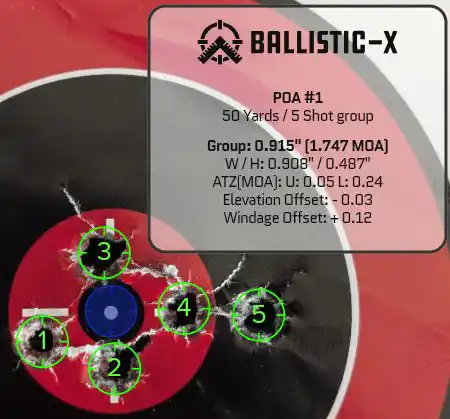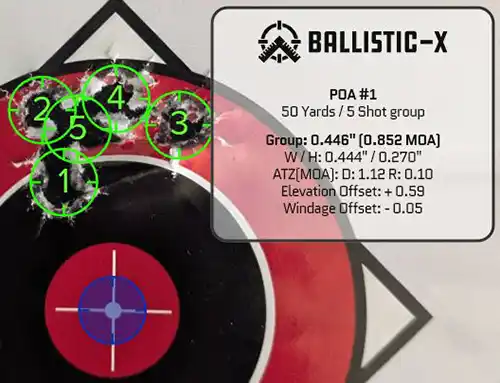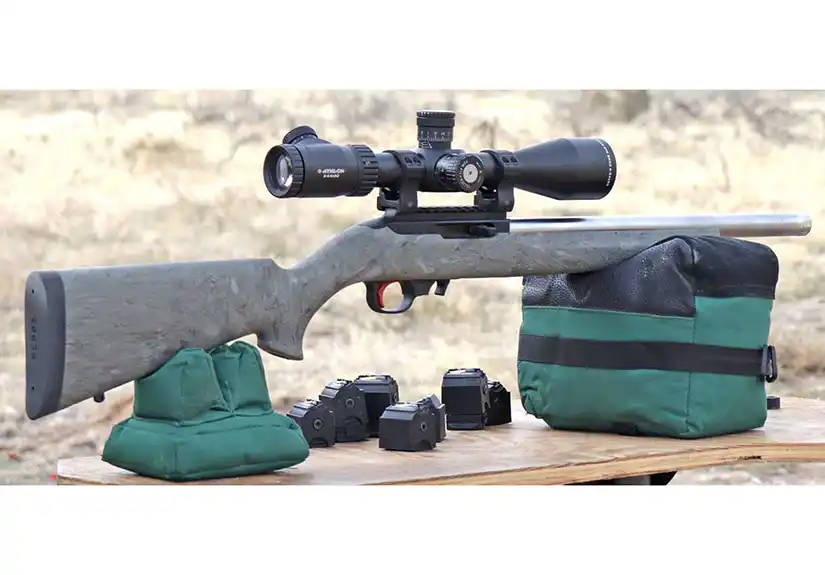After years of building and shooting custom 10/22-based rifles, the Bear Creek Arsenal BC-201 landed in my collection. This is a 10/22 clone utilizing a mix of in-house and aftermarket parts. It checks all the boxes for both new and seasoned shooters. Featuring a heavy stainless (and threaded) barrel, integrated rail on the receiver, decent trigger, and a Hogue stock, it offers a lot for its $345 price tag. Looking at it, everything is better than a factory rifle, but it’s not a full competition rifle. Here’s a breakdown of my short time with it.
Bear Creek Arsenal BC-201 full specs
At its core is a 7075-T6 aluminum receiver with an integrated Picatinny rail. Inside is BCA’s own match bolt with a proprietary charging handle and what appears to be a Ruger BX trigger. BCA describes their barrel as “Match grade” but no chamber specifications are provided. It’s 416R stainless, 16″ long, and 0.920″ diameter, threaded 1/2×28 with an 11 degree target crown and a 1:16 twist. In other words, all the things you might want in a rifle that could be used for both casual target shooting, and hunting small game.

Sitting in a Hogue overmold stock which free-floats all but the first few inches of the barrel, this rifle definitely looks pretty good on paper. Especially considering that the price for this complete rifle is less than some triggers and barrels alone. And of course it uses standard Ruger 10/22 magazines (it ships with one), which are inexpensive and plentiful. At this point, if it shoots well, it’s won me over.

Prepping for range time
After picking this rifle up from my FFL, the first thing I did was dig around for a suitable scope. I had an Argos BTR GEN2 6-24×50 and some Vortex rings which seemed like a good fit. Installing the scope and zeroing it with a laser was all I did to this rifle before taking it to the range. Well, I had a peek down the bore to check for obstructions too, and ran the bolt a few times. And dry-fired the trigger. But no disassembly, no torquing the action screw. Running it right out of the box was my plan.
A note about the trigger
In the past, at least one retailer sold three different “tiers” of the BX trigger. All had the same SKU from the manufacturer, but the pull weights varied. And that has always been a point of contention for me. My Bear Creek Arsenal BC-201 has what I guess is one of the better ones, with a little creep and pre-travel, then a light break that’s not super crisp, but perfectly acceptable. If all their rifles have similar triggers, it’s going to be hard to justify spending more on a replacement. Even a “drop in” hammer, sear, and shoe upgrade is going to be over $125, but won’t make $125 worth of a difference.
My initial range trip with the Bear Creek Arsenal BC-201
Figuring that most buyers of this rifle aren’t going to feed it match ammo, I brought some bulk ammo, and CCI SV. With a few small adjustments to the scope, I was able to hit a golf ball at 50 yards, and keep driving it out to about 100 yards. Shooting ammo that’s roughly 12% faster than my usual ammo makes a difference in delivered energy on a target, even if it’s not the most accurate. Translation: it’s fun to shoot bulk ammo out of this rifle if you’re not shooting for groups.
Switching to the CCI SV, I threw my suppressor on, and started aiming at empty shotgun hulls which litter the ground out to roughly 50 yards. My point of impact didn’t seem to have any meaningful change, though the lower velocity ammo required an elevation adjustment the farther I shot.
Again, I hit pretty much everything I aimed at, but we’re still talking about targets of more than a half inch at 50 yards. The only times it failed to fire, there were very solid strikes on the case. So I chalked that up to ammo. Extraction was consistent, with no issues. If I was buying this as a plinker to stay completely stock, I would have had no complaints with it.
A quick tear-down and look inside
Once I had a few hundred rounds through it, I took the BC-201 apart. I was mostly curious about the bolt and charging handle, as they seem to be the only proprietary parts. Removing a single screw allows the charging handle to come off. With that out of the way, I was able to remove the bolt. I’m not a fan of proprietary parts, but the bolt appears well-made, with proper headspace, a sharp extractor, and a firing pin that made it go bang every time. Unless the round was defective, of course. Overall fit and finish is nice, and it’s running smoothly without lube.
Back to the range
Working around Mother Nature, I had to skip shooting the following weekend due to very cold temps and snow. On my next trip, it was 40 degrees, but thankfully, there was no wind and the snow had melted. Setting up a target at 50 yards, I proceeded to shoot some disappointing groups of around 1″ with the CCI SV. And then I remembered I was shooting a $345 rifle, with $5/box ammo. Precision bolt actions have spoiled me. In reality, 2 MOA for this setup is plenty respectable, and is also just a starting point. Experimenting with action screw torque and different ammo should certainly improve that. One of the better groups with CCI is shown below.

Rummaging through my range bag, I found a box of SK Semi-Auto. Normally, I wouldn’t go right to this ammo without having some more rounds through the rifle. But I was curious. With only a few shots to condition my barrel to this lubed ammo I had smaller groups, some even under 1 MOA. That’s more of what I was hoping for, and hints at what this rifle may be capable of. Since I was out of SK, I went back to shooting CCI, and if nothing else, the groups were at least consistent in size. Below is one of the best groups with SK.

Final thoughts on the Bear Creek Arsenal BC-201
Clearly, this rifle has some potential, and if the weather cooperates, I may get a chance to try some better ammo through it. The barrel should be good enough that most shooters won’t find a need to upgrade it. And Ruger’s BX trigger, while certainly not match grade, is a common upgrade already. I don’t think anyone hates these Hogue stocks, but even if you’re not a fan, that’s an easy swap. If you want a different charging handle, you’ll need to change out the entire bolt. But the BC-201 ships with a perfectly functional bolt, so that’s a tough call.
Going into this review, I expected most buyers would be using CCI SV because it’s widely available, consistent, and suppresses well. And that’s because I figured the Bear Creek Arsenal BC-201 was just a budget-friendly rifle with some “better than stock” parts. Turns out it may be the winner in value 10/22 clones. It’s more than a base rifle from Ruger, but far less than a custom. Yet I suspect that more time testing different ammo will yield even better results than what I achieved. And if you just want a better than average plinker, it already delivers. Check it out at bearcreekarsenal.com.
As always, I’d like to thank Bear Creek Arsenal for providing their BC-201 for my testing and evaluation. It’s great to see another player in this space, offering a quality rifle at an affordable price.
User Experiences & FAQs
Real shooter experiences
- Forum posts on AR15.com and RimfireCentral.com note the BC-201’s Hogue stock and stainless barrel give a nicer shooting feel than a standard 10/22 without breaking the bank.
- Range reports highlight consistent function with standard Ruger 10/22 magazines and common ammo – CCI SV and SK Semi-Auto were often mentioned as reliable options.
- Community feedback appreciates the integrated Picatinny rail for optics and the easy bolt removal for cleaning and maintenance.
- Reddit threads (r/22lr / r/10_22) confirm the BC-201 is a popular choice for new shooters looking for better-than-stock performance at a budget price.
FAQs (Bear Creek Arsenal BC-201)
Is the BC-201 better than a stock Ruger 10/22?
Yes. It features a free-floating Hogue stock, match-grade barrel, integrated rail, and a functional BX trigger. Users report better ergonomics, improved accuracy, and more flexibility for optics compared to stock 10/22 rifles.
Which magazines are compatible?
Standard Ruger 10/22 magazines fit perfectly. They’re inexpensive, plentiful, and perform reliably in testing with bulk, CCI SV, and SK Semi-Auto rounds. No proprietary magazines are required.
How accurate is the BC-201 out of the box?
Expect 1–2 MOA with common target ammo. SK Semi-Auto rounds and careful scope setup yielded groups under 1 MOA in some cases. Further tuning, barrel break-in, and ammo experimentation can improve precision.
Are the bolt and charging handle proprietary?
Yes, the BC-201 uses a proprietary bolt and charging handle. However, the bolt is well-made, fully functional, and reliable with standard 10/22 magazines. Replacement parts are available from Bear Creek Arsenal if needed.
Can I upgrade the trigger or stock?
The BX trigger is perfectly usable and consistent. For those seeking a crisper pull, aftermarket 10/22 upgrades are compatible. Hogue stocks can also be swapped if desired, though most shooters find the included stock comfortable and durable.
Is the barrel threaded for suppressors?
Yes, the 16″ stainless barrel is threaded 1/2×28 with an 11° target crown. Users report easy mounting of suppressors or muzzle devices without additional modifications.
Any maintenance tips?
Keep the bolt and chamber clean and lightly lubricated. The rifle runs smoothly out of the box, but periodic cleaning ensures consistent performance, especially after firing bulk ammo or running hundreds of rounds.
Who is this rifle best for?
New shooters, budget-conscious enthusiasts, or anyone wanting a better-than-stock 10/22 clone. It’s ideal for plinking, small-game hunting, and general range fun without investing in a fully custom rifle.
